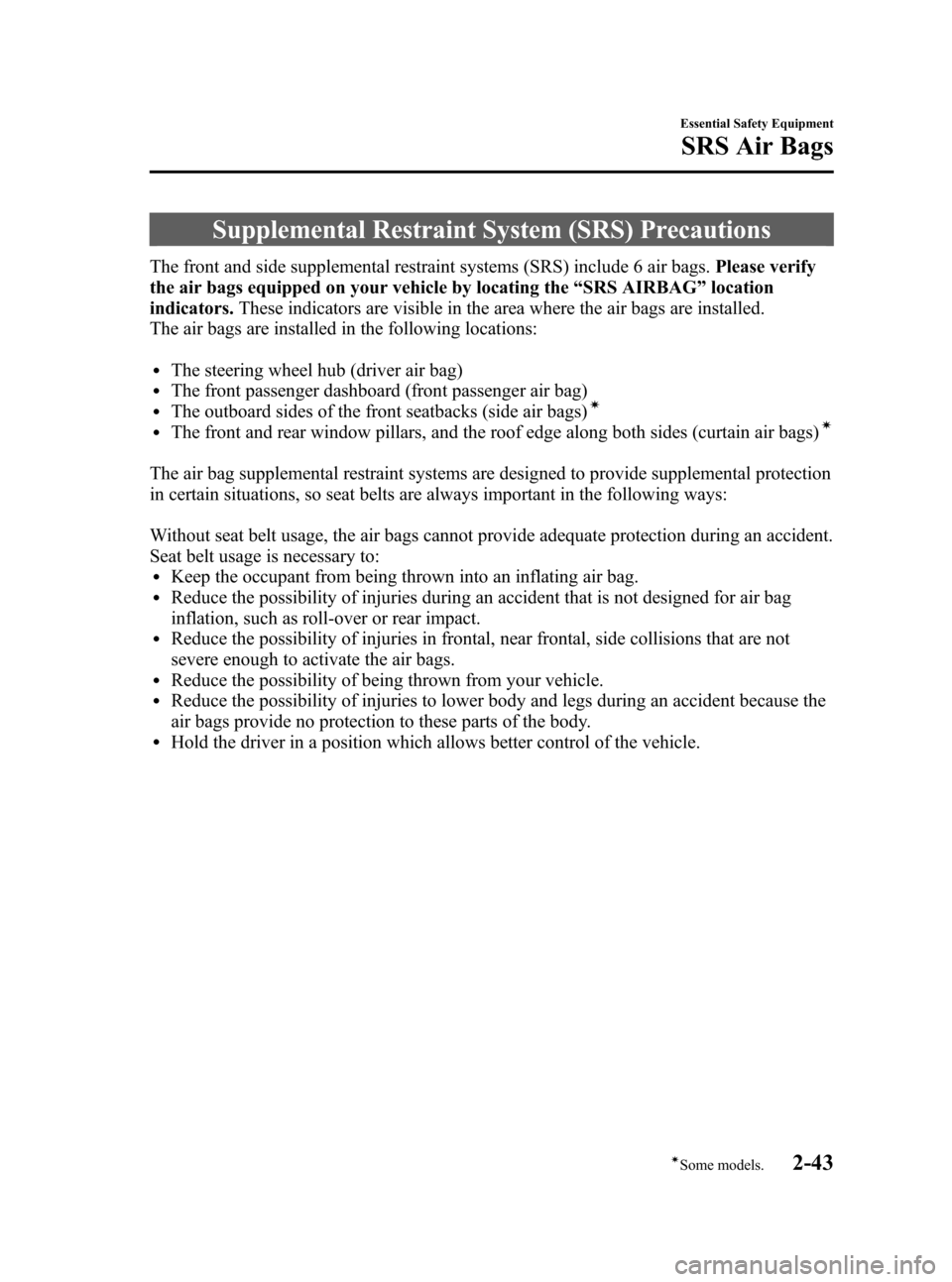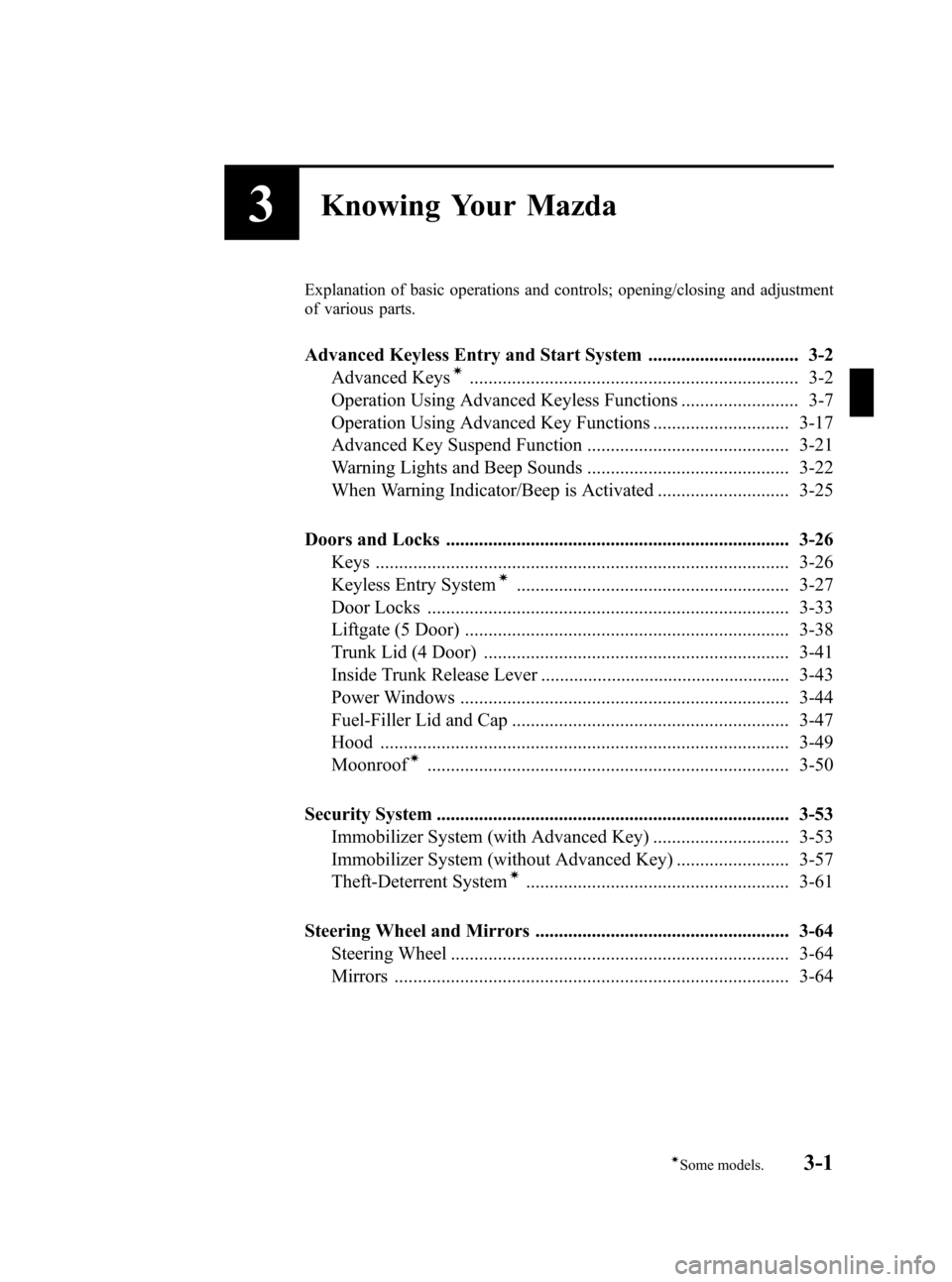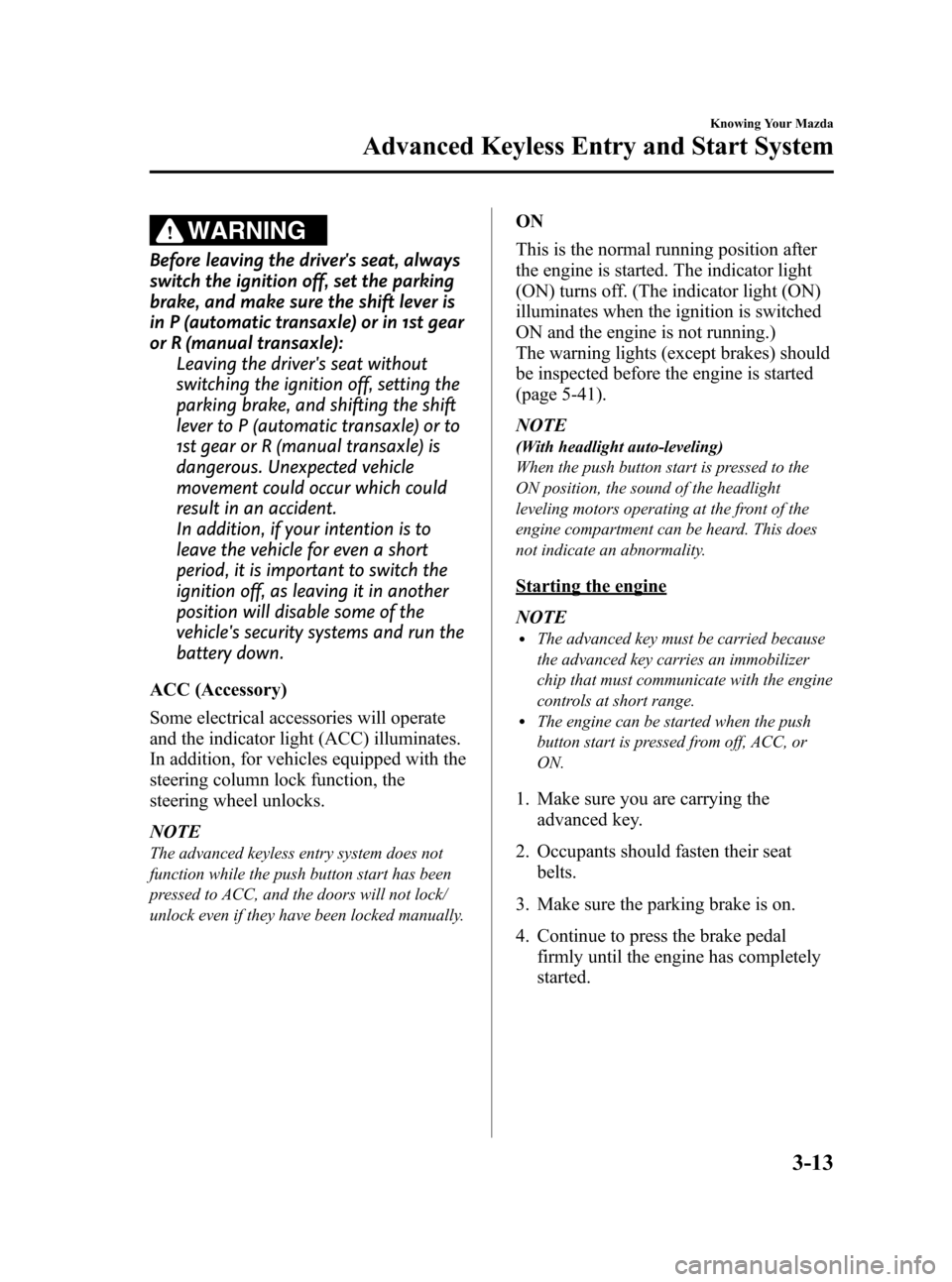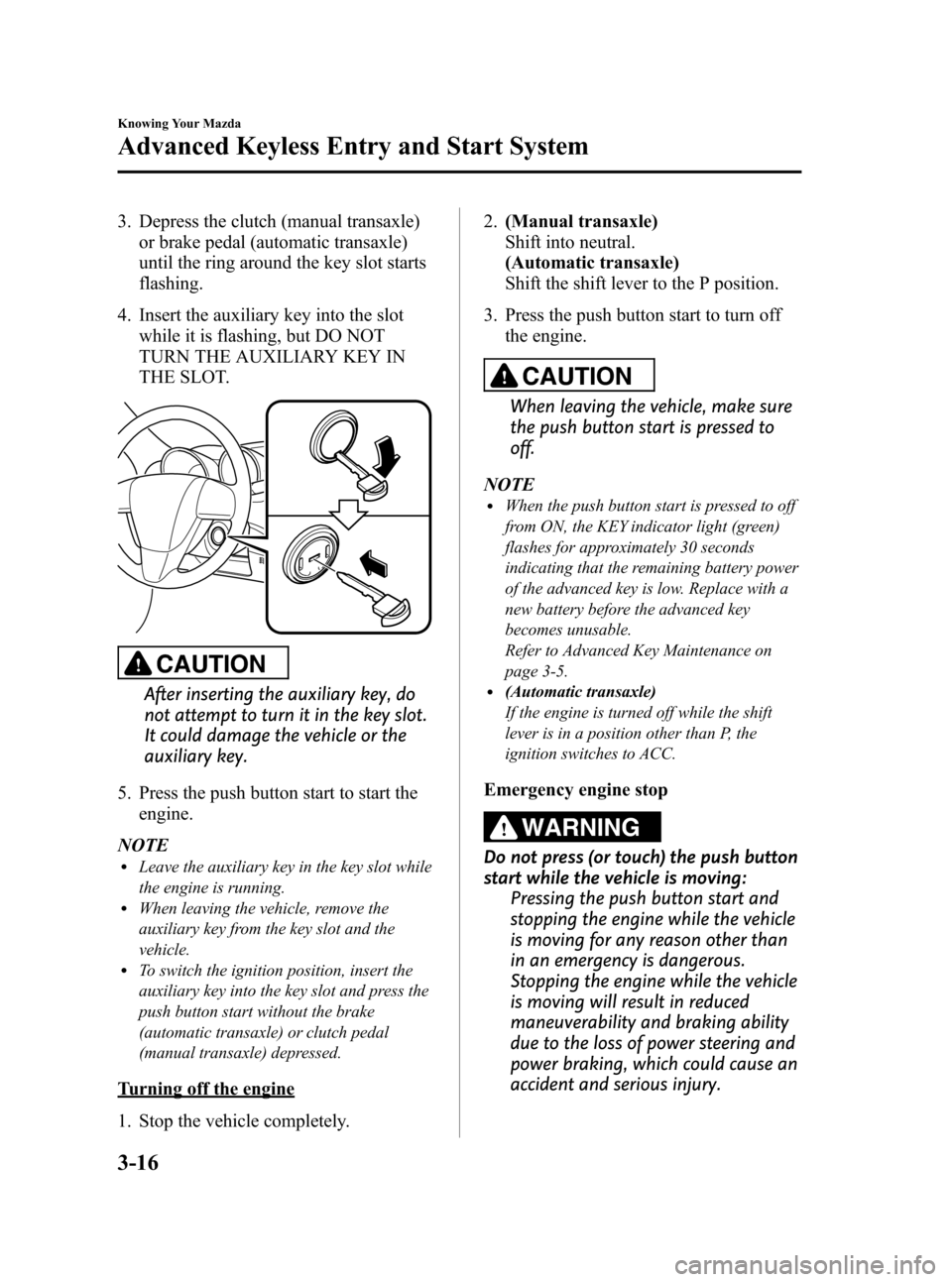steering MAZDA MODEL 3 HATCHBACK 2011 Owners Manual (in English)
[x] Cancel search | Manufacturer: MAZDA, Model Year: 2011, Model line: MODEL 3 HATCHBACK, Model: MAZDA MODEL 3 HATCHBACK 2011Pages: 509, PDF Size: 5.75 MB
Page 58 of 509

Black plate (57,1)
Supplemental Restraint System (SRS) Precautions
The front and side supplemental restraint systems (SRS) include 6 air bags.Please verify
the air bags equipped on your vehicle by locating the “SRS AIRBAG ”location
indicators. These indicators are visible in the area where the air bags are installed.
The air bags are installed in the following locations:
lThe steering wheel hub (driver air bag)lThe front passenger dashboard (front passenger air bag)lThe outboard sides of the front seatbacks (side air bags)í
lThe front and rear window pillars, and the roof edge along both sides (curtain air bags)í
The air bag supplemental restraint systems are designed to provide supplemental protection
in certain situations, so seat belts are always important in the following ways:
Without seat belt usage, the air bags cannot provide adequate protection during an accident.
Seat belt usage is necessary to:
lKeep the occupant from being thrown into an inflating air bag.lReduce the possibility of injuries during an accident that is not designed for air bag
inflation, such as roll-over or rear impact.
lReduce the possibility of injuries in frontal, near frontal, side collisions that are not
severe enough to activate the air bags.
lReduce the possibility of being thrown from your vehicle.lReduce the possibility of injuries to lower body and legs during an accident because the
air bags provide no protection to these parts of the body.
lHold the driver in a position which allows better control of the vehicle.
Essential Safety Equipment
SRS Air Bags
2-43íSome models.
Mazda3_8BM6-EC-10F_Edition1 Page57
Monday, June 7 2010 2:31 PM
Form No.8BM6-EC-10F
Page 60 of 509

Black plate (59,1)
Never use a rear-facing child-restraint system in the front seat with an air bag that
could deploy:Rear-facing child-restraint systems on the front seat are particularly dangerous even
though you may feel assured that a front passenger air bag will not deploy based on
the fact that the front passenger air bag deactivation indicator light illuminates. The
child-restraint system can be hit by a deploying air bag and moved violently
backward resulting in serious injury or death to the child.
Do not sit too close to the driver and front passenger air bags:
Sitting too close to the driver and front passenger air bag modules or placing hands
or feet on them is extremely dangerous. The driver and front passenger air bags
inflate with great force and speed. Serious injuries could occur if someone is too
close. The driver should always hold onto only the rim of the steering wheel. The
front seat passenger should keep both feet on the floor. Front seat occupants should
adjust their seats as far back as possible and always sit upright against the
seatbacks with seat belts worn properly.
Sit in the center of the seat and wear seat belts properly: Sitting too close to the side air bag modules or placing hands on them, or sleeping
up against the door or hanging out the windows is extremely dangerous. The side
and curtain air bags inflate with great force and speed directly expanding along the
door on the side the car is hit. Serious injury could occur if someone is sitting too
close to the door or leaning against a window, or if rear seat occupants grab the
sides of the front seatbacks. Give the side and curtain air bags room to work by
sitting in the center of the seat while the vehicle is moving with seat belts worn
properly.
Do not attach objects on or around the area where driver and front passenger air
bags deploy: Attaching an object to the driver and front passenger air bag modules or placing
something in front of them is dangerous. In an accident, an object could interfere
with air bag inflation and injure the occupants.
Essential Safety Equipment
SRS Air Bags
2-45
Mazda3_8BM6-EC-10F_Edition1 Page59
Monday, June 7 2010 2:31 PM
Form No.8BM6-EC-10F
Page 64 of 509

Black plate (63,1)
How the SRS Air Bags Work
Your Mazda is equipped with the following types of SRS air bags. SRS air bags are
designed to work together with the seat belts to help to reduce injuries during an accident.
The SRS air bags are designed to provide further protection for passengers in addition to
the seat belt functions. Be sure to wear seat belts properly.
qFront Seat Belt Pretensioners
The front seat belt pretensioners are designed to deploy in moderate or severe frontal, near
frontal collisions.
qDriver Air Bag
The driver's air bag is mounted in the steering wheel.
When air bag crash sensors detect a frontal impact of greater than moderate force, the
driver's air bag inflates quickly helping to reduce injury mainly to the driver's head or chest
caused by directly hitting the steering wheel.
For more details about air bag deployment, refer to “SRS Air Bag Deployment Criteria ”
(page 2-53).
(With Driver and Front Passenger Occupant Classification System)
The driver's dual-stage air bag controls air bag inflation in two energy stages. During an
impact of moderate severity the driver's air bag deploys with lesser energy, whereas during
more severe impacts, it deploys with more energy.
q Front Passenger Air Bag
The front passenger air bag is mounted in the front passenger dashboard. The inflation
mechanism for the front passenger air bag is the same as the driver's air bag, as mentioned
above.
For more details about air bag deployment, refer to “SRS Air Bag Deployment Criteria ”
(page 2-53).
Essential Safety Equipment
SRS Air Bags
2-49
Mazda3_8BM6-EC-10F_Edition1 Page63
Monday, June 7 2010 2:31 PM
Form No.8BM6-EC-10F
Page 71 of 509

Black plate (70,1)
Driver and Front Passenger Occupant Classification Systemí
First, please read“Supplemental Restraint System (SRS) Precautions” (page 2-43)
carefully.
q Driver Seat Slide Position Sensor
Your vehicle is equipped with a driver seat slide position sensor as a part of the
supplemental restraint system. The sensor is located under the driver seat. The sensor
determines whether the driver seat is fore or aft of a reference position and sends the seat
position to the diagnostic module (SAS unit). The SAS unit is designed to control the
deployment of the driver air bag depending on how close the driver seat is to the steering
wheel.
The air bag/front seat belt pretensioner system warning light flashes if the sensor has a
possible malfunction (page 2-51).
qFront Passenger Seat Weight Sensors
Your vehicle is equipped with a front passenger seat weight sensors as a part of the
supplemental restraint system. These sensors are located under both of the front passenger
seat rails. These sensors determine the total seated weight on the front passenger seat and
monitor the seat belt buckle for the front passenger seat. The SAS unit is designed to
prevent the front passenger front and side air bags and seat belt pretensioner system from
deploying if the front passenger air bag deactivation indicator light illuminates.
To reduce the chance of injuries caused by deployment of the front passenger air bag, the
system deactivates the front passenger front and side air bags and also the seat belt
pretensioner system when the front passenger air bag deactivation indicator light
illuminates. Refer to the following table for the front passenger air bag deactivation
indicator light illumination conditions.
This system shuts off the front passenger front and side air bags and seat belt pretensioner
system, so make sure the front passenger air bag deactivation indicator light illuminates
according to the following table.
The air bag/front seat belt pretensioner system warning light flashes and the front
passenger air bag deactivation indicator light illuminates if the sensors have a possible
malfunction. If this happens, the front passenger front and side air bags and seat belt
pretensioner system will not deploy.
2-56
Essential Safety Equipment
íSome models.
SRS Air Bags
Mazda3_8BM6-EC-10F_Edition1 Page70
Monday, June 7 2010 2:31 PM
Form No.8BM6-EC-10F
Page 77 of 509

Black plate (76,1)
WARNING
Do not operate a vehicle with damaged air bag/seat belt pretensioner system
components:Expended or damaged air bag/seat belt pretensioner system components must be
replaced after any collision which caused them to deploy or damage them. Only a
trained Authorized Mazda Dealer can fully evaluate these systems to see that they
will work in any subsequent accident. Driving with an expended or damaged air bag
or pretensioner unit will not afford you the necessary protection in the event of any
subsequent accident which could result in serious injury or death.
Do not remove interior air bag parts: Removing any components such as the front seats, front dashboard, the steering
wheel or parts on the front and rear window pillars and along the roof edge,
containing air bag parts or sensors is dangerous. These parts contain essential air
bag components. The air bag could accidentally activate and cause serious injuries.
Always have an Authorized Mazda Dealer remove these parts.
Dispose of the air bag properly: Improper disposal of an air bag or a vehicle with live air bags in it can be extremely
dangerous. Unless all safety procedures are followed, injury can result. Ask an
Authorized Mazda Dealer how to safely dispose of an air bag or how to scrap an air
bag equipped vehicle.
NOTE
If it becomes necessary to have the components or wiring system for the supplementary restraint
system modified to accommodate a person with certain medical conditions in accordance with a
certified physician, contact an Authorized Mazda Dealer, refer to “Customer Assistance (U.S.A.) ”
(page 9-2).
2-62
Essential Safety Equipment
SRS Air Bags
Mazda3_8BM6-EC-10F_Edition1 Page76
Monday, June 7 2010 2:31 PM
Form No.8BM6-EC-10F
Page 78 of 509

Black plate (77,1)
3Knowing Your Mazda
Explanation of basic operations and controls; opening/closing and adjustment
of various parts.
Advanced Keyless Entry and Start System ................................ 3-2Advanced Keysí...................................................................... 3-2
Operation Using Advanced Keyless Functions ......................... 3-7
Operation Using Advanced Key Functions ............................. 3-17
Advanced Key Suspend Function ........................................... 3-21
Warning Lights and Beep Sounds ........................................... 3-22
When Warning Indicator/Beep is Activated ............................ 3-25
Doors and Locks ......................................................................... 3-26 Keys ........................................................................................ 3-26
Keyless Entry System
í.......................................................... 3-27
Door Locks ............................................................................. 3-33
Liftgate (5 Door) ..................................................................... 3-38
Trunk Lid (4 Door) ................................................................. 3-41
Inside Trunk Release Lever ..................................................... 3-43
Power Windows ...................................................................... 3-44
Fuel-Filler Lid and Cap ........................................................... 3-47
Hood ....................................................................................... 3-49
Moonroof
í............................................................................. 3-50
Security System ........................................................................... 3-53 Immobilizer System (with Advanced Key) ............................. 3-53
Immobilizer System (without Advanced Key) ........................ 3-57
Theft-Deterrent System
í........................................................ 3-61
Steering Wheel and Mirrors ...................................................... 3-64 Steering Wheel ........................................................................ 3-64
Mirrors .................................................................................... 3-64
3-1íSome models.
Mazda3_8BM6-EC-10F_Edition1 Page77
Monday, June 7 2010 2:31 PM
Form No.8BM6-EC-10F
Page 89 of 509

Black plate (88,1)
qStarting the Engine
Locking the steering wheel
If the electronic steering lock warning
light is flashing and the beep sound is
heard, this indicates that the steering
wheel is not unlocked. To unlock the
steering wheel, jiggle the steering wheel
from side to side while pressing the push
button start.
Ignition positions
Each time the push button start is pressed,
the ignition switches in the order of off,
ACC, and ON. Pressing the push button
start again from ON switches the ignition
off.
Indicator light
Indicator
light (ACC)
Indicator
light (ON)
NOTElThe order in which the ignition is switched
can be changed.
Refer to Personalization Features on page
10-12.
lThe engine starts by pressing the push
button start while depressing the clutch
pedal (manual transaxle) or the brake
pedal (automatic transaxle). To switch the
ignition position, press the push button start
without depressing the pedal.
lDo not leave the ignition switched ON
while the engine is not running. Doing so
could result in the battery going dead. If the
ignition is left in ACC (For automatic
transaxle, the shift lever is in the P position,
and the ignition is in ACC), the ignition
switches off automatically after one hour.
The setting can be changed to not switch
the ignition off automatically.
Refer to Personalization Features on page
10-12.
Off
The power supply to electrical devices
turns off and the push button start
indicator lights (ACC and ON) also turn
off.
3-12
Knowing Your Mazda
Advanced Keyless Entry and Start System
Mazda3_8BM6-EC-10F_Edition1 Page88
Monday, June 7 2010 2:32 PM
Form No.8BM6-EC-10F
Page 90 of 509

Black plate (89,1)
WARNING
Before leaving the driver's seat, always
switch the ignition off, set the parking
brake, and make sure the shift lever is
in P (automatic transaxle) or in 1st gear
or R (manual transaxle):Leaving the driver's seat without
switching the ignition off, setting the
parking brake, and shifting the shift
lever to P (automatic transaxle) or to
1st gear or R (manual transaxle) is
dangerous. Unexpected vehicle
movement could occur which could
result in an accident.
In addition, if your intention is to
leave the vehicle for even a short
period, it is important to switch the
ignition off, as leaving it in another
position will disable some of the
vehicle's security systems and run the
battery down.
ACC (Accessory)
Some electrical accessories will operate
and the indicator light (ACC) illuminates.
In addition, for vehicles equipped with the
steering column lock function, the
steering wheel unlocks.
NOTE
The advanced keyless entry system does not
function while the push button start has been
pressed to ACC, and the doors will not lock/
unlock even if they have been locked manually.
ON
This is the normal running position after
the engine is started. The indicator light
(ON) turns off. (The indicator light (ON)
illuminates when the ignition is switched
ON and the engine is not running.)
The warning lights (except brakes) should
be inspected before the engine is started
(page 5-41).
NOTE
(With headlight auto-leveling)
When the push button start is pressed to the
ON position, the sound of the headlight
leveling motors operating at the front of the
engine compartment can be heard. This does
not indicate an abnormality.
Starting the engine
NOTE
lThe advanced key must be carried because
the advanced key carries an immobilizer
chip that must communicate with the engine
controls at short range.
lThe engine can be started when the push
button start is pressed from off, ACC, or
ON.
1. Make sure you are carrying the advanced key.
2. Occupants should fasten their seat belts.
3. Make sure the parking brake is on.
4. Continue to press the brake pedal firmly until the engine has completely
started.
Knowing Your Mazda
Advanced Keyless Entry and Start System
3-13
Mazda3_8BM6-EC-10F_Edition1 Page89
Monday, June 7 2010 2:32 PM
Form No.8BM6-EC-10F
Page 93 of 509

Black plate (92,1)
3. Depress the clutch (manual transaxle)or brake pedal (automatic transaxle)
until the ring around the key slot starts
flashing.
4. Insert the auxiliary key into the slot while it is flashing, but DO NOT
TURN THE AUXILIARY KEY IN
THE SLOT.
CAUTION
After inserting the auxiliary key, do
not attempt to turn it in the key slot.
It could damage the vehicle or the
auxiliary key.
5. Press the push button start to start the engine.
NOTE
lLeave the auxiliary key in the key slot while
the engine is running.
lWhen leaving the vehicle, remove the
auxiliary key from the key slot and the
vehicle.
lTo switch the ignition position, insert the
auxiliary key into the key slot and press the
push button start without the brake
(automatic transaxle) or clutch pedal
(manual transaxle) depressed.
Turning off the engine
1. Stop the vehicle completely. 2.
(Manual transaxle)
Shift into neutral.
(Automatic transaxle)
Shift the shift lever to the P position.
3. Press the push button start to turn off the engine.
CAUTION
When leaving the vehicle, make sure
the push button start is pressed to
off.
NOTE
lWhen the push button start is pressed to off
from ON, the KEY indicator light (green)
flashes for approximately 30 seconds
indicating that the remaining battery power
of the advanced key is low. Replace with a
new battery before the advanced key
becomes unusable.
Refer to Advanced Key Maintenance on
page 3-5.
l(Automatic transaxle)
If the engine is turned off while the shift
lever is in a position other than P, the
ignition switches to ACC.
Emergency engine stop
WARNING
Do not press (or touch) the push button
start while the vehicle is moving: Pressing the push button start and
stopping the engine while the vehicle
is moving for any reason other than
in an emergency is dangerous.
Stopping the engine while the vehicle
is moving will result in reduced
maneuverability and braking ability
due to the loss of power steering and
power braking, which could cause an
accident and serious injury.
3-16
Knowing Your Mazda
Advanced Keyless Entry and Start System
Mazda3_8BM6-EC-10F_Edition1 Page92
Monday, June 7 2010 2:32 PM
Form No.8BM6-EC-10F
Page 141 of 509

Black plate (140,1)
Steering Wheel
WARNING
Never adjust the steering wheel while
the vehicle is moving:Adjusting the steering wheel while
the vehicle is moving is dangerous.
Moving it can very easily cause the
driver to abruptly turn to the left or
right. This can lead to loss of control
or an accident.
qSteering Wheel Adjustment
To change the angle or length of the
steering wheel:
1. Stop the vehicle, pull up the lock
release lever under the steering
column.
Lock release lever
2. Tilt the steering wheel and/or adjust thesteering column length to the desired
positions, push the lever down to lock
the column.
3. Push the wheel up and down to be certain it's locked before driving.
Mirrors
qOutside Mirrors
Check the mirror angles before driving.
Mirror type
Flat type (driver's side)
Flat surface mirror.
Convex type (front passenger side)
The mirror has single curvature on its
surface.
WARNING
Be sure to look over your shoulder
before changing lanes:
Changing lanes without taking into
account the actual distance of the
vehicle in the convex mirror is
dangerous. You could have a serious
accident. What you see in the convex
mirror is closer than it appears.
Power mirror
The ignition must be switched to ACC or
ON.
To adjust:
1. Press the left or right side of the
selector switch to choose the left or
right side mirror.
3-64
Knowing Your Mazda
Steering Wheel and Mirrors
Mazda3_8BM6-EC-10F_Edition1 Page140
Monday, June 7 2010 2:32 PM
Form No.8BM6-EC-10F